by Marilyn Muir, LPMAFA

This work is licensed under a Creative Commons Attribution-NonCommercial-ShareAlike 4.0 International License.
On August 20, 1977, the space probe Voyager II was launched from Cape Canaveral, Florida. It was sent out by NASA to study the solar system’s outer planets. On September 5, 1977, its twin, Voyager I, was launched with a similar mission – the study of the outer planets. Both Voyager space probes carried the Golden Record of our world into the Cosmos. Because of differing mission directives and trajectories, Voyager I actually encountered two of the outer planets before Voyager II, and thereby became more prominent in our news reporting. Voyager II actually visited four outer planets: Jupiter, Saturn, Uranus and Neptune. and completed its primary mission. It now has an “extended mission to study the outer reaches of our Solar System”. While it is in a conserve power mode, it has completed forty years of continuous flight and operation as of August 20, 2017. It is currently in the helios shield area of our outer solar system and has not crossed the heliopause threshold for interstellar space.
Voyager I, because of its mission directive and trajectory, got to fly by Jupiter first, its closest approach on March 5, 1979. Voyager I continued to Saturn and did its flyby of both Saturn and its moon Titan on November 12, 1980. As close as I can tell from the NASA reported timeline, Voyager I completed its passage of the heliopause where the outgoing energy (the solar wind) from our Sun gives way to the incoming energies (the interstellar wind) from outer space on August 25, 2012, at a distance of 121 AU (18 billion km from the Sun). Voyager I crossed into interstellar space into the cosmos.
Again for energy conservation, Voyager I’s main thrusters were shut down November 8, 1980. As time, travel, and space itself wore down the directional thrusters, it became necessary to see if the main thrusters could be re-fired and substituted in service. Last week, on November 28,2017, 37+ years after shutdown, those primary thrusters were, once again re-fired and will be pressed into directional service. The maneuver worked! Now the same procedure is under consideration for Voyager II, to prolong the life of the equipment, the mission and the amazing scientific information that can still be contributed by both probes, one in actual interstellar space, and one approaching it through the helios shield. Both probes are still functioning and able to contribute, and the science lab has prolonged their usefulness for a few more years. YES!
I wondered about the launches and how those flyby activations would look astrologically. I chose Voyager I to research first since it has already crossed into interstellar space. We have an accurate launch time and five active dates to examine. The same procedure will be done for Voyager II in part 2 of this study.
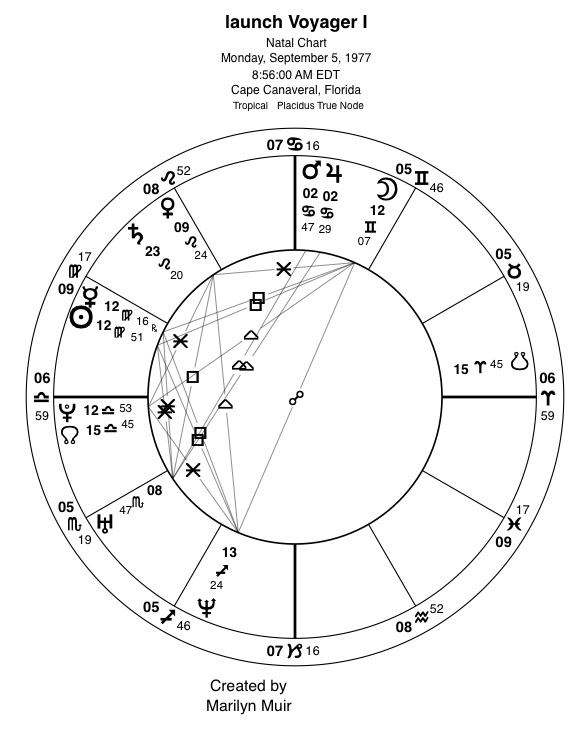
Voyager I launch: September 5, 1977, 12:56 UTC (8:56 AM EDT), Cape Canaveral, FL
- The launch chart has 6 Libra 59 rising, with Pluto in the first house 12:53 and the North Node close by also in the first house at 15:45.
- The four angles complete a tight grand cross, Midheaven 7 Cancer 16, conjunct Mars/Jupiter in the ninth house at 2 Cancer 29-47.
- This is a space shot to our solar system’s outer limits and beyond: cardinal (initiation) on the angles and with a Mars/Jupiter conjunction in the house of long-distance travel. (Jupiter’s semi-major axis is 778.57 million km from the Sun and it was the nearest of the four bodies.)
- Exploring the unknown (unconscious) is very Plutonian and the Nodes give a character of karma or destiny.
- The chart ruler is Venus at 9 Leo 24, square Uranus at 8 Scorpio 47; the Uranus challenge to invent, reveal, open new horizons pushing the very social lady Venus in the eleventh house of group efforts, the science team.
- One more pattern dominates this chart, a mutable T-square involving four planets with Moon 12 Gemini 07 in the ninth opposing Neptune 13 Sagittarius 24 in the third (travel houses) square Mercury at 12 Virgo 16 retrograde and Sun 12 Virgo 51 in the twelfth house. So much of the flight was very twelfth house, time/duration/silence, behind-the-scenes work.
- Perhaps the retrograde Mercury was evidenced by the twin probes launched within such a short time of one another (sixteen days), each with a unique mission. This flight was number 2 in launch, number 1 by designation.
What about the ongoing events? I chose diurnals* to illustrate the activity.
*Diurnal: For event or activity in question use the natal chart data changing only the date for the activity itself. Change nothing else! This provides a personal transit chart for that event complete with Ascendant and Midheaven.
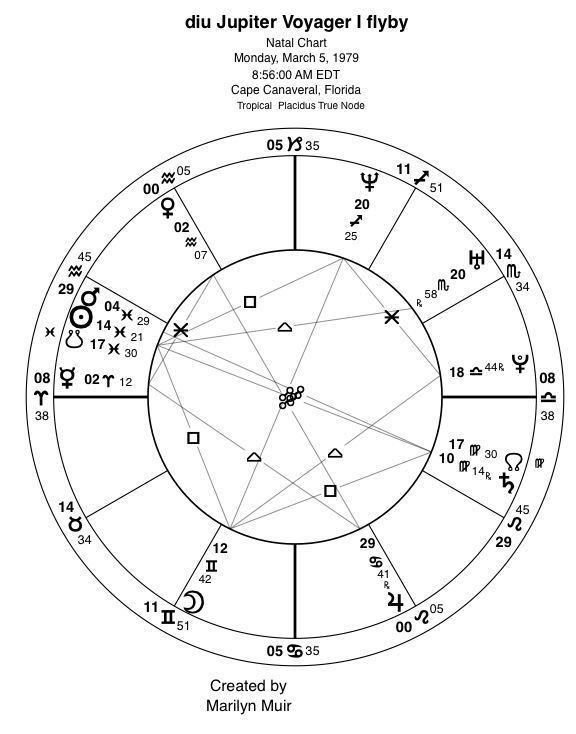
Jupiter Flyby (Note: Do not change the time standard from the natal launch chart.)
The closest approach to Jupiter was March 5, 1979, only 1.5 years after the launch. The flyby angles happen to be quite close to the launch chart.
- Flyby Midheaven is at 5 Capricorn 35 and the Ascendant 8 Aries 38.
- Flyby Mercury 2 Aries 12 is tightly square the launch Mars/Jupiter conjunction. Chart-wise Jupiter is involved in its own flyby.
- The launch chart ruler Venus is 2 Aquarius 07 opposite retrograde Jupiter at 29 Cancer 41. Transiting Jupiter is specifically involved in the Jupiter flyby again!
- Remember that launch Moon/Neptune opposition? There it is again 1.5 years later, with the flyby Moon within a half-degree of its launch position.
- For this flyby event, the Moon position of the Moon/Neptune opposition is also squared by the Sun 14 Pisces 21 and South Node 17 Pisces 30.
- Back to the mutable T-square. It was now strengthened with the addition of retrograde Saturn at 10 Virgo 14. Flyby chart ruler Mars is in that mutable complex but quite wide in orb, 4 Pisces 29 in the twelfth with Pisces intercepted. This was a scientific achievement, photos, data, not as much in the spotlight.
Voyager I had a close encounter with Jupiter as the event-ruling Venus/opposed Jupiter and the event Mercury triggered the natal Jupiter/Mars as the Sun occupied Pisces. And “they” say this stuff doesn’t work!
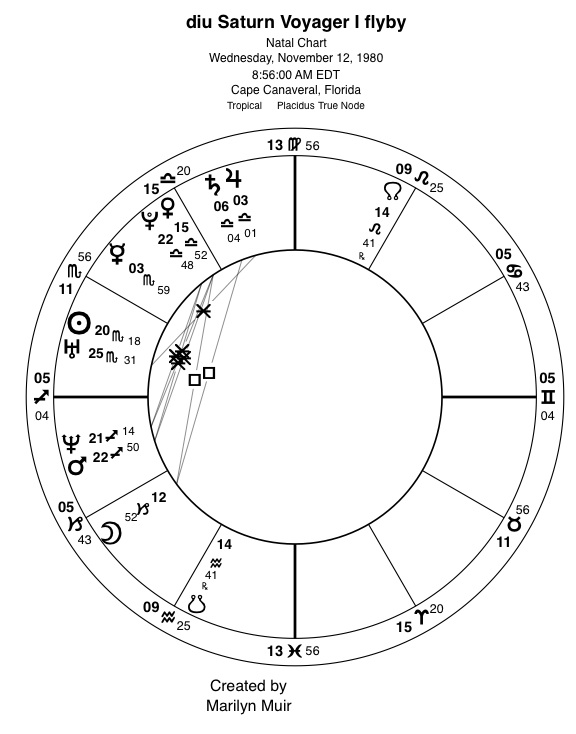
Saturn/Titan Flyby (Note: Do not change the time standard from the launch chart.)
Saturn’s semi-major axis is 1,433.53 million KM from the Sun. The closest approach for both Saturn and Titan was collective on November 12, 1980.
- Flyby Midheaven 13 Virgo 56 conjunct the launch Sun/Mercury conjunction and tightly squaring the launch Moon/Neptune opposition.
- Flyby Jupiter 3 Libra 01 conjunct Saturn 6 Libra 04 is right on the launch Ascendant.
- Flyby Moon is square launch Pluto.
- Flyby Venus is tightly conjunct the launch Pluto/North Node conjunction.
- This is a Saturn flyby, so it is not a surprise that the flyby Sun/Uranus conjunction is tightly square the launch Saturn (Saturn was the traditional ruler of Aquarius, the sign of the flyby South Node).
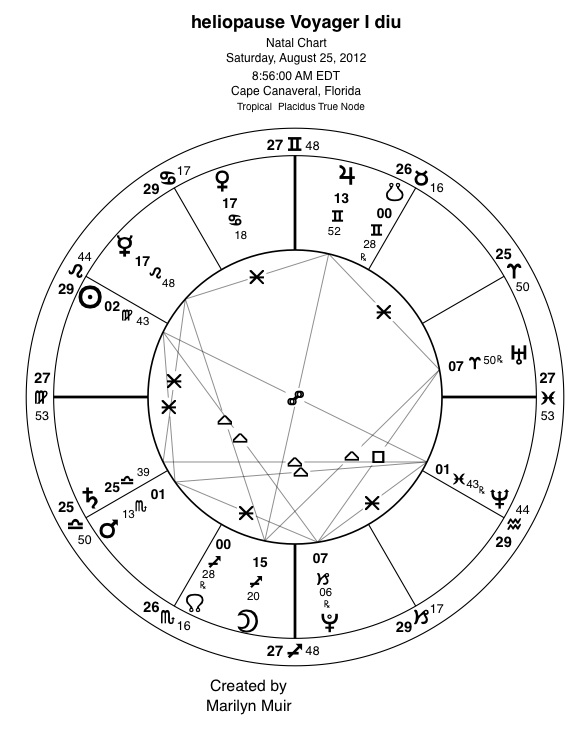
Heliopause There was some confusion but the official NASA date is August 25, 2012.
How in this world do we decide what represents the place where our Sun’s control over our system switches to intergalactic energy? Where do we locate that astrologically? How about the black hole at the very center of our Milky Way Galaxy’s center (Sagittarius A), approximately 28 Sagittarius at the time of the launch forty years ago?
- Will a tight conjunction to the heliopause chart IC 27 Sagittarius 48 do it for you?
- Or if that is too speculative, how about heliopause Pluto 7 Capricorn 06R just 10 minutes from the V-1 launch IC?
- How about a tight Moon 15 Sagittarius 20 / Jupiter 13 Gemini 52 opposition tightly triggering that launch mutable T-square?
- How about heliopause Venus 17 Can 18 square launch Pluto near the launch North Node?
- How about heliopause Uranus 7 Aries 50R conjunct the launch Descendant?
How many tight connections do you need for proof?
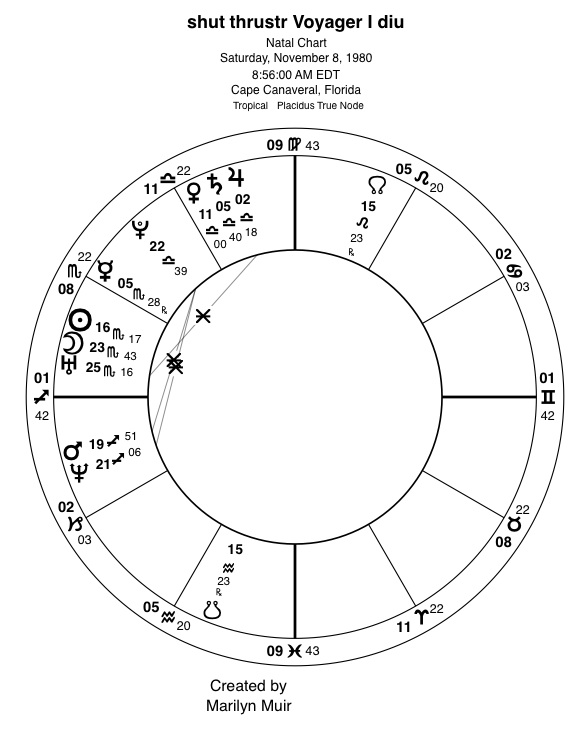
Thrusters: off again, on again (Note: Do not change launch time standard for these events.)
Remember that I mentioned that the main thrusters were shut down on Nov 8, 1980. This was just a few days prior to the Saturn/Titan flyby. Can we see the relatively minor activation to the launch chart from that diurnal?
- The shutdown Midheaven 9 Virgo 43 tightly triggers the launch mutable T-square.
- Shutdown Jupiter 2 Libra 18 squares the launch Mars/Jupiter conjunction.
- Shutdown Venus 11 Libra 00 conjuncts launch Pluto.
Lots of astrological activity for the simple act of shutting off the thrusters. Fast forward 37 years…
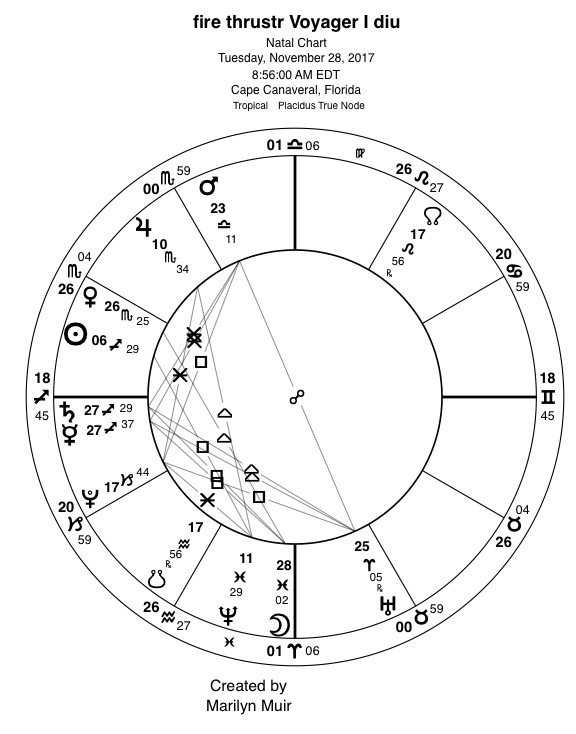
Re-firing of those thrusters November 28, 2017, was eight days ago as I write this article.
- Re-fire Midheaven 1 Libra 06, square the launch Mars/Jupiter conjunction, opposing the re-fire Moon out of sign but about 3 degrees applying.
- Re-fire Neptune 11 Pisces 29 triggering the launch mutable T-square.
- Re-fire Pluto 17 Capricorn 44 square launch North Node.
Perhaps you have noticed that I emphasized the cardinal and mutable aspects in these charts. That is because they had to do with rulership of events and houses. There were connections between fixed positions as well. I also focused on hard aspects for this initial study: conjunction, square and opposition. Why? I see them as action aspects and the softer aspects as support and flow. This is a man-made probe that sits atop a monster rocket and gets blasted out into space to face the unknown with little to no help should anything go wrong. Sextiles and trines just don’t do that. They may help succeed, but they do not risk.
Understand also there always is more to see/find. Every time I pick up a chart, I see more than I saw initially. This study is enough to show the interconnectedness of the charts from one launch to its five specific activations.
This exercise should also show you that just because something constitutes an event, it cannot be separate from the process that engendered that event and its ongoing ramifications. Life is a process, a series of interconnected events and activities, sometimes even a cascading event process. It is not about isolated or unconnected events. Study the process inherent in all events.
Part 2 – Voyager II
Now we will look at Voyager II which technically was in space prior to Voyager I, and we will follow the same technical procedure. Use the launch for the base chart and flybys of the space probe to the four outer planets that it visited. This will provide us with a comparison to see if the basic principles we developed for Voyager 1 hold up for Voyager 2. To avoid confusion, I have marked these new chart positions V-2 or V-1 where necessary to maintain clarity.
Voyager 2 was launched August 20, 1977, 14:29:00 UTC (10:29:00 EDT), Cape Canaveral, FL.
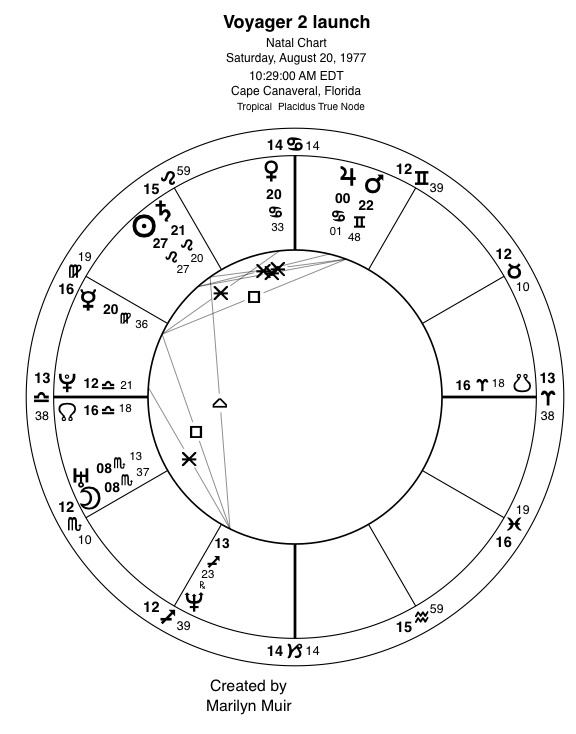
Repeating the Voyager I launch cardinal angular cross, Voyager II angles have somewhat later cardinal degrees, but are also in tight square to one another. The Ascendant is 13 Libra 38, with Pluto in the twelfth house at 12:21 and the North Node in the first house at 16:18. Both are square the Midheaven at 14 Cancer 14, and with chart-ruler Venus widely conjunct the Midheaven in the tenth house at 20:33.
The ruler of the Midheaven, Moon 8 Scorpio 37, is tightly conjunct Uranus at 8:13 late in the first house.
There is a wide, separating (weakening) Sun/Saturn conjunction from 21 Leo 20 to 27:27. Why weakening? The aspect perfected prior to launch: process.
The V-2 Mars/Jupiter launch conjunction evident in Voyager I had not fully formed for this launch, however both planets are again in the ninth house and Neptune is still in the third house, both transportation houses. Understand that V-2 preceded V-1 in launch, but its trajectory made it reach Jupiter and then Saturn/Titan later than V-1. The Mars/Jupiter conjunction was developing for this launch (V-2) and had fully developed and was pivotal for the launch of V-1. V-1 got to the planets first… it had the stronger aspect.
The V-2 launch Mars and Mercury are in close applying square with launch Mercury in the twelfth house. So much of what these charts represent are twelfth house energies with the long silence of space and the continual behind-the-scenes activity. Not negative, just indicative of the use and application of these energies.
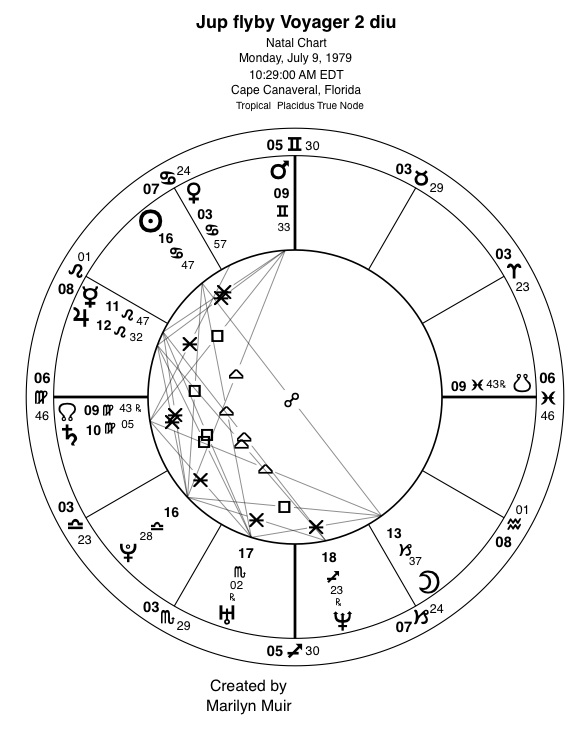
Voyager II Jupiter flyby The first planetary flyby for Voyager II was Jupiter on July 9, 1979, 22:29:00 UTC.
The launch positions for both probes were based at Cape Canaveral, FL. The flybys are up close and personal with the planets themselves. We are using diurnals to show the information and activations between the launch of the individual space probe and its personal experience in outer space. We do have times of encounter for Voyager 2. But if you were to the cast a chart for the flyby of a planet, how do you correlate its location to the Earth date and Universal time? I stayed with traditional diurnals so I would compare apples to apples, one launch at a time.
The Voyager II launch focused on mid degrees cardinal so we start work there.
- V-2 Jupiter flyby Sun 16 Cancer 47 opposed Moon 13 Capricorn 37 (Full Moon) square Pluto 16 Lib 28 triggering the mid-range cardinal planets in the V-2 launch grand cross.
- V-2 Jupiter flyby Midheaven 5 Gemini 30 conjunct Mars 9:33, both square Ascendant 6 Virgo 46, North Node 9:43 and Saturn 10:05, a tight active complex relative to this event.
- V-2 Jupiter flyby chart ruler Mercury is 11 Leo 47 conjunct flyby Jupiter 12:32. Jupiter is dignified (strong) in the twelfth house. The chart ruler is conjunct the planet being visited… definitely appropriate.
- The V-2 launch chart ruler was Venus. The V-2 Jupiter flyby Venus at 3 Cancer 57 is widely conjunct launch Jupiter at 00 Cancer 01.
Remember, first flyby honors for Jupiter and Saturn went to Voyager 1, that got to do this first.
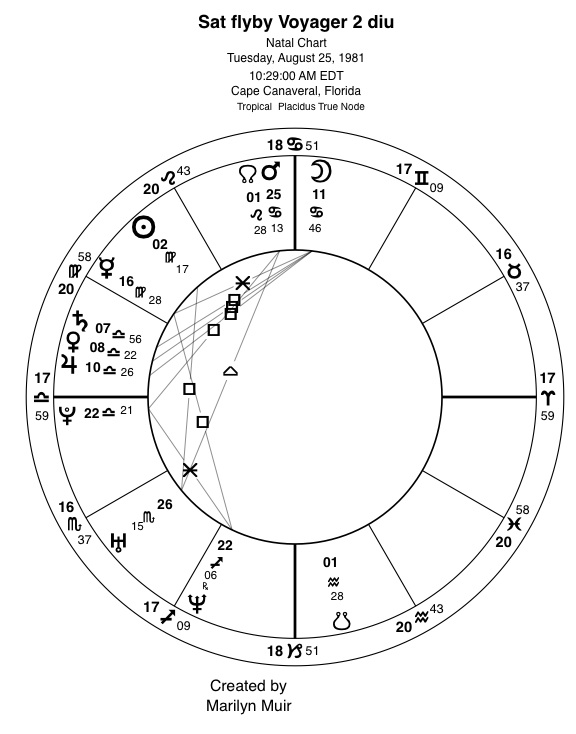
Voyager II’s Saturn flyby occurred on August 25, 1981, 3:24:05 UTC
- Cardinal degrees all over the place, eight of primary thirteen positions ranging from 8 to 25 degrees with multiple activations.
- Venus is again this chart ruler for the V-2 flyby of Saturn, look first to the Saturn/Venus conjunction 7 Libra 56 to 8:22, also conjunct Jupiter 10:26, square flyby Moon 11 Cancer 46 triggering the cardinal previously listed.
- V-2 Saturn flyby Neptune 22 Sagittarius 06 opposed (triggering) V-2’s launch Mars at 22 Gemini 48, square V-2 launch Mercury 20 Virgo 36 creating a T-square (action) between the charts.
Now Voyager II got to do some firsts of its own.
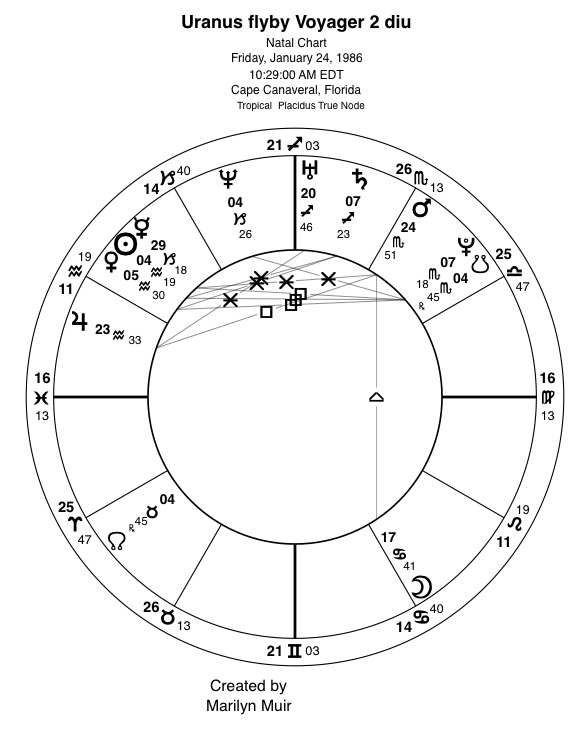
Voyager II’s Uranus flyby occurred January 24, 1986, 17:59:47 UTC (Note: Do not change the launch chart time standard for this diurnal.)
- Look at Uranus directly conjunct the V-2 Uranus flyby Midheaven 20 Sagittarius 46 to 21:03. As the Midheaven represents the goal or mission of the event, this is so specific!
- A Sun/Venus close conjunction (4:19 to 5:30) in Aquarius is joined by Mercury 29 Capricorn 18 in a wider and out of sign conjunction. Uranus is the ruler of Aquarius and there are three planets in Aquarius for this rendezvous, with Jupiter as chart ruler in its mundane dignity in the twelfth house. This Jupiter is receiving stimulation from Mars at 24 Scorpio 51 in the late eighth house (destiny) on the ninth house cusp (far journeys).
- What about V-2’s launch Uranus conjunct Moon at 8 Scorpio? V-2’s flyby Pluto is 7 Scorpio 18.
- We should not forget the mid-cardinal degrees so strong in the V-2 launch chart. The Uranus flyby Moon is 17 Cancer 41, triggering that entire complex.
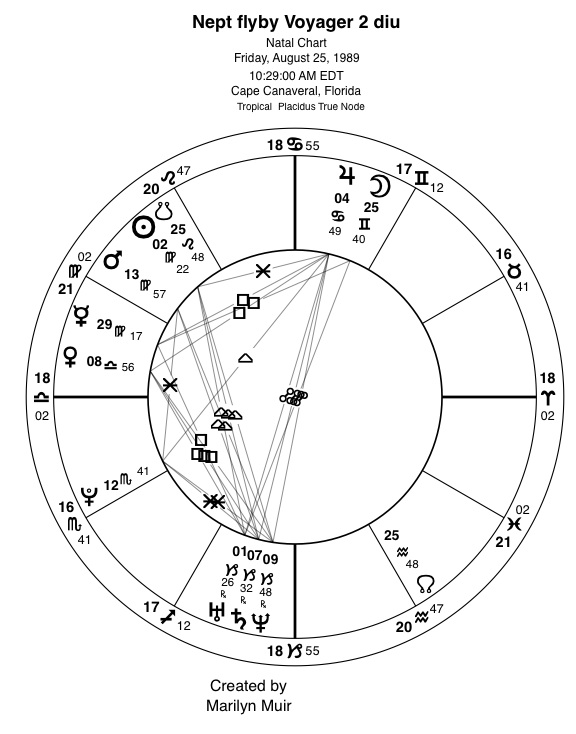
Voyager 2 Neptune flyby occurred August 25, 1989, 3:56:36 UTC Voyager II’s Neptune flyby is a WOW!
- Mid-cardinal angular cross with a Uranus/Saturn/Neptune conjunction in early Capricorn opposed by Jupiter in early Cancer and a wide but applying out of sign Moon.
- Remember that a transiting (diurnal) Moon travels one degree of actual motion every two hours on the clock. As the fastest moving body, the Moon at 25 Gemini 40 will move from one to anther in this T-square complex within the 24 hours of its originating position. It will square flyby Mercury in the twelfth at 29 Virgo 17. This flyby was technically the end of its stated mission to flyby the four outer planets. Anything past this point becomes part of its extended mission and is still in progress.
- Also note that this flyby Moon had just activated the V-2 launch Mars at 22 Gemini 48 about six hours earlier on the day’s clock. V-2 launch Mars was square launch Mercury, both Mercuries in their respective twelfth houses. I read that as technical, detailed, backup and support, transmission of photo and data, all behind the scenes activity.
- V-2 launch Neptune is 13 Sagittarius 23, tightly squared by Neptune flyby Mars at 13 Virgo 57. Neptune flyby, Neptune trigger.
Because the scientists took advantage of the lineup of the four outer planets, Voyager II had a much longer journey and has not yet gone through the heliopause. Both space probes celebrated forty years in their journey this year – amazing feats. They are both functional in a curtailed way to prolong their life cycle and contribution.
Planetary Patterns
I have not done anything with planetary patterns other than the traditional T-squares and grand crosses described throughout.
Now I need to remedy that omission and point out that this V-2 Neptune flyby has a Bowl pattern, with Neptune and the Moon as rim planets that guide and direct the energy of the bodies they contain. I have pointed out that as the Moon travels forward, it will trigger first one than another of the major T-square planets… in this order: square Mercury, opposed Uranus, conjunct Jupiter, opposed Saturn, square Venus, opposed Neptune. Later in its passage, it will square the Ascendant/Descendant axis and then conjunct the Midheaven and oppose the I.C. This is a perfect example of the process involved in such an event. It is an event, but it is also one moment of a long-term, ongoing process with many parts… and this particular process still has life in it!
What about the natal V-2 launch pattern? A Bowl pattern again, with a Neptune/Mars opposition as rim planets. From my understanding, bowl patterns contain the available energies, but need a catalyst to spring into action… lots of preparation, with triggers to catapult that preparation into activity. This pattern has the mutable T-square for a trigger.
Looking back at the Voyager I launch (also a Bowl pattern), it has the Moon/Neptune opposition as rim planets and a mutable T-square of planets as trigger.
Voyager I Saturn/Titan flyby had the Lunar Nodes as rim, what Astrologer Connie Cummings termed a nodal barrier in a long-ago article. Nodes are points in space. In this instance, they serve to contain the energies, not the usual planetary bodies as rim. Cummings described this as a chart and life almost “entrapped” to perform in a certain way, almost karmically bound. The ten bodies contained within the nodal barrier are tightly bundled, within 100 degrees of zodiacal space, a quite single-purpose objective. What do you do if you are a probe in outer space, going “where no man has gone before”, robotic or externally commanded in choice? I think this fits the Cummings description of the nodal barrier. V-1 completed its original planetary exploration mission at that point and moved on to experience the outer edges of the solar system where it gives way to interstellar space.
Note: the shutting off of the thrusters for Voyager 1 occurred within four days of the Saturn/Titan flyby, so that chart also has the nodal barrier as rim positions with an even tighter bundling of the physical bodies, all ten contained within 79 degrees! Talk about intended purpose within the nodal boundary (karmic)!
Re-firing of the V-1 thrusters again gives a nearly perfect bowl, all ten bodies within 182 degrees with the tight Mars/Uranus opposition as rim planets. This was something never tried before (Uranus), a re-firing (Mars) of engine (Mars) for power (Mars), again (retrograde Uranus).
V- 2 Saturn flyby was tighter than a bowl, about 160 degrees of space, moving towards a bundle pattern, very dedicated or focused. Again the Moon and Neptune are rim planets.
V-2 Uranus flyby was a lopsided Bucket or Funnel chart with the Moon as singleton widely separating (13 degrees) from the opposition to Neptune. Lopsided strikes me as a good word for a Uranus flyby, considering its polar axis is tilted 98˚ resting near the Ecliptic (planetary path).
The charts not listed for pattern did not meet the criteria for a specific pattern being more freeform or “splash” in layout.
Stelliums, clusters
I do lots of historical research astrologically. It is my personal experience that planetary stelliums or clusters occur frequently in important happenings or to the people involved in important happenings. I checked all the charts used in this concept. Results:
- V-1 shut thrusters: Libra stellium: Jupiter, Saturn, Venus, Pluto; Scorpio stellium: Mercury, Sun, Moon, Uranus; 53 degree cluster: eight planets.
- V-1 Saturn/Titan flyby: Libra stellium intact, Scorpio: Mercury, Sun, Uranus; 53-degree cluster: seven planets.
- V-1 re-fire thrusters: Sagittarius stellium: Sun, Saturn, Mercury plus Ascendant.
- V-2 Saturn flyby: Libra stellium: Saturn, Venus, Jupiter, Pluto plus Ascendant.
- V-2 Neptune flyby: Virgo stellium: Sun, Mars, Mercury; Capricorn stelliium: Uranus, Saturn, Neptune.
Final notes
We can see many repetitions in each of these intentionally brief descriptions of these twelve events. There is individual definition between the two probes, but they are on a common mission. There are three more commonalities I would point out.
- Pluto is conjunct the Ascendants for both V-1 and V-2 launches and the V-2 Saturn flyby.
- The North Node is conjunct the Ascendants for both launches and the V-2 Jupiter flyby.
- Venus is amazingly active in both of the probe series. Why Venus? Think of the nature of the teamwork necessary to plan, implement, and guide the ongoing process for more than forty years… twin probes on a common mission, each with its own schedule and goal.
I think it is easy to lose sight of the enormity of how these connections work astrologically beginning in 1977, through all the years of both silence and activity, and celebrating forty years in 2017. The probes are still alive, they are still able to generate, transmit, photograph and function for NASA’s scientists while in a carefully selected life preservation mode. V-1 has been in interstellar space for years. V-2 is getting closer to the heliopause and the encounter with interstellar space. Science has to be selective in its use of the probes because they do have a finite life cycle and they are now exploring the infinite. They… and we… have more work to do.
Sources and timelines: NASA and
https://en.wikipedia.org/wiki/Voyager_1
https://en.wikipedia.org/wiki/Voyager_2
https://en.wikipedia.org/wiki/Heliosphere
Voyager, Nov 5, 2018 crossed Heliopause
https://nypost.com/2018/12/10/nasas-voyager-2-makes-milestone-move-into-interstellar-space/
Note: If someone knows how to get the position of Titan for each launch and Saturn flyby, it would be interesting to see if any of that data matches the chart positions used for this study.
Published in the Journal of Research of the American Federation of Astrologers, vol 18 August, 2017, republished with slight editing.
Freebie: Voyager 2 crossed the Heliopause Nov 5, 2018; its launch diurnal is:
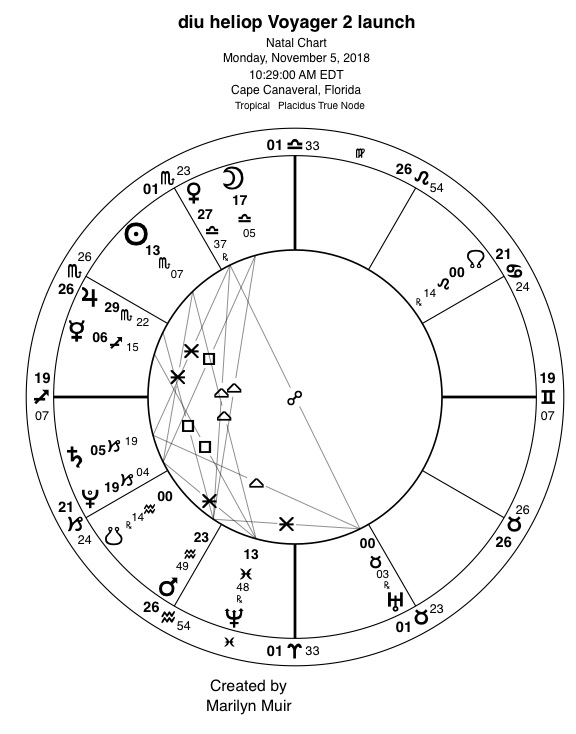

This work is licensed under a Creative Commons Attribution-NonCommercial-ShareAlike 4.0 International License.